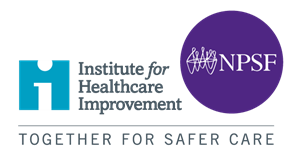Leading for Safety
Healthcare leaders are guided by the highest calling—to care for those who entrust their care to us, and to make a difference. We believe this can only happen when leaders lead with intent. Leading with intent requires that leaders stand for something. Amid all the competing priorities, the most important thing leaders can stand for and lead for, is safety.
The American College of Healthcare Executives and the IHI Lucian Leape Institute (formerly the Institute for Healthcare Improvement/National Patient Safety Foundation Lucian Leape Institute) partnered to help healthcare leaders lead for safety through creating and sustaining a culture of safety.
As you know, leading for safety is a journey—it’s a marathon and not a sprint. There are many highs and lows on this journey. Sometimes things are moving forward and other times a little reboot can be helpful. This site provides you and your leadership team with practices to develop your team and to keep moving forward on this critical journey.
Leading A Culture of Safety: A Blueprint for Success
Creating a culture of safety in healthcare settings is a challenging endeavor. Until now, there have not been clear roadmaps for organizational leaders to take in developing such a culture. So, we collaborated with leaders of progressive healthcare organizations and globally renowned experts in leadership, safety and culture to develop the resource, Leading a Culture of Safety: A Blueprint for Success.
The blueprint gives CEOs and senior leaders a tool to both assess and advance their organization’s culture of safety. Through systematic, small steps, this process of improvement becomes a motivating experience, rather than an overwhelming one. The blueprint outlines clear strategies and tactics that can help inform dialogue with board members and leadership teams, help executives establish priorities, and encourage accountability and follow-up actions.
We Lead for Safety
Improving healthcare safety requires leaders who are committed and take a stand to achieve the highest standards of safety. Strong leadership involves balancing core values while consistently raising the bar for excellence.
ACHE’s leadership development expertise coupled with the IHI Lucian Leape Institute’s in-depth insight on safety practices, offers healthcare leaders the foundational tools to measure, build and sustain a culture of safety in the workplace.
- Commit to leading for safety by signing our We Lead for Safety pledge and receive a Leading For Safety certificate.
- Assess Your Safety Culture by taking this self-assessment.
Once you take the pledge to commit to a culture of safety and assess your current safety measures, we will continue to provide you with scalable steps and guideposts on the path to major progress.
Leading a Culture of Safety: A Blueprint for Success contains best practices and guidance to help you choose your first action steps. And we will continue to provide timely information, tools and resources to support your commitment to safety.
"One of the most critical roles we must fulfill is ensuring the safety of patients who entrust their lives to our care, as well as ensuring the safety of a workforce—both clinical and nonclinical—that entrusts their livelihoods to our organizations. It is the ultimate duty of leaders to ensure the safety and prevention of unnecessary harm to these individuals and their loved ones."

Webinar Recording
Safer Together: Healthcare’s New Resource to Guide Safer Care
Experts and contributors to the National Action Plan highlight four foundational focus areas outlined in the report—culture, leadership and governance; patient and family engagement; workforce safety; and learning systems— focusing on the critical role of leaders in each of these domains. This session is co-developed by ACHE and the Institute for Healthcare Improvement.
Re-Committing to Patient Safety in the COVID-19 Era
Patricia McGaffigan, vice president of safety programs at the Institute for Healthcare Improvement, discusses the driving forces behind the new National Safety Action Plan developed by IHI, ACHE and 25 other industry-leading organizations to help healthcare providers move toward zero-harm.



